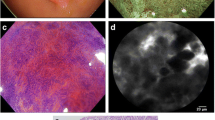Abstract
Background
Fujifilm has developed a novel endoscope system with two kinds of lasers that enables us to allow narrow-band light observation with blue laser imaging (BLI). The aim of this study was to evaluate BLI magnification in comparison with narrow-band imaging (NBI) magnification for the diagnosis of colorectal neoplasms.
Methods
This was a multicenter open study. A total of 104 colorectal neoplasms were examined with BLI and NBI magnifications in Kyoto Prefectural University of Medicine and Fukuoka University Chikushi Hospital. Vascular and surface patterns of tumors under BLI magnification were compared with those under NBI magnification, using a published NBI classification. The main outcome was the correlation between the NBI classification diagnosed by BLI or NBI magnification and the histopathological analyses.
Results
Sixty-two cases of adenoma, 34 cases of intramucosal cancer and shallowly invaded submucosal cancer, and eight cases of deeply invaded submucosal cancer were diagnosed. The diagnostic accuracy of BLI magnification in the NBI classification was 74.0 % (77/104), similar to that of NBI magnification (77.8 %). The consistency rate between BLI and NBI magnification in the NBI classification was 74.0 %. Concerning image evaluation, the interobserver variability of two expert endoscopists (N.Y. and T.H.) in BLI magnification was κ = 0.863. On the other hand, the intraobserver variability of the two endoscopists was κ = 0.893 (N.Y.) and 0.851 (T.H.).
Conclusions
BLI magnification by laser source could predict histopathological diagnosis and invasion depth of colorectal neoplasms. The diagnostic effectiveness of this method was similar to that of NBI magnification.





Similar content being viewed by others
References
Saito Y, Uraoka T, Yamaguchi Y, et al. A prospective, multicenter study of 1111 colorectal endoscopic submucosal dissections (with video). Gastrointest Endosc. 2010;72:1217–25.
Yoshida N, Naito Y, Inada Y, et al. Efficacy of endoscopic mucosal resection with 0.13% hyaluronic acid solution for colorectal polyps: a randomized controlled trial. J Gastroenterol Hepatol. 2012;27:1377–83.
Yoshida N, Naito Y, Yagi N, Yoshikawa T. Safe procedure in endoscopic submucosal dissection for colorectal tumors focused on preventing complications. World J Gastroenterol. 2010;16:1688–95.
Kitajima K, Fujimori T, Fujii S, et al. Correlations between lymph node metastasis and depth of submucosal invasion in submucosal invasive colorectal carcinoma: a Japanese collaborative study. J Gastroenterol. 2004;39:534–43.
Kudo S, Hirota S, Nakajima T, et al. Colorectal tumours and pit pattern. J Clin Pathol. 1994;47:880–5.
Tobaru T, Mitsuyama K, Tsuruta O, Kawano H, Sata M. Sub-classification of type VI pit patterns in colorectal tumors: relation to the depth of tumor invasion. Int J Oncol. 2008;33:503–8.
Fu KI, Sano Y, Kato S, et al. Chromoendoscopy using indigo carmine dye spraying with magnifying observation is the most reliable method for differential diagnosis between non-neoplastic and neoplastic colorectal lesions: a prospective study. Endoscopy. 2004;36:1089–93.
Kaltenbach T, Sano Y, Friedland S, et al. American Gastroenterological Association (AGA) Institute technology assessment on image-enhanced endoscopy. Gastroenterology. 2008;134:327–40.
Sano Y, Ikematsu H, Fu KI, et al. Meshed capillary vessels by use of narrow-band imaging for differential diagnosis of small colorectal polyps. Gastrointest Endosc. 2009;69:278–83.
Ikematsu H, Matsuda T, Emura F, et al. Efficacy of capillary pattern type IIIA/IIIB by magnifying narrow band imaging for estimating depth of invasion of early colorectal neoplasms. BMC Gastroenterol. 2010;10:33.
Kanao H, Tanaka S, Oka S, et al. Narrow-band imaging magnification predicts the histology and invasion depth of colorectal tumors. Gastrointest Endosc. 2009;69:631–6.
Tanaka S, Sano Y. Aim to unify the narrow band imaging (NBI) magnifying classification for colorectal tumors: current status in Japan from a summary of the consensus symposium in the 79th Annual Meeting of the Japan Gastroenterological Endoscopy Society. Dig Endosc. 2011;23(Suppl 1):131–9.
Miyake Y, Sekiya T, Kubo S, et al. A new spectrophotometer for measuring the spectral reflectance of gastric mucous membrane. J Photogr Sci. 1989;37:134–8.
Yoshida N, Naito Y, Inada Y, et al. The detection of surface patterns by flexible spectral imaging color enhancement without magnification for diagnosis of colorectal polyps. Int J Colorectal Dis. 2012;27:605–11.
Yoshida N, Naito Y, Kugai M, et al. Efficacy of magnifying endoscopy with flexible spectral imaging color enhancement in the diagnosis of colorectal tumors. J Gastroenterol. 2011;46:65–72.
Hamilton SR, Aaltonen LA, editors. World Health Organization classification of tumors. Pathology and genetics of tumours of the digestive system. Lyon, France: IARC Press; 2010. p. 104–9.
Japanese Society for Cancer of the Colon and Rectum, editor. Japanese Classification of Colorectal Carcinoma. 2nd English ed. Tokyo: Kanehara & Co., Ltd; 2009.
Machida H, Sano Y, Hamamoto Y, et al. Narrow-band imaging in the diagnosis of colorectal mucosal lesions: a pilot study. Endoscopy. 2004;36:1094–8.
Higashi R, Uraoka T, Kato J, et al. Diagnostic accuracy of narrow-band imaging and pit pattern analysis significantly improved for less-experienced endoscopists after an expanded training program. Gastrointest Endosc. 2010;72:127–35.
Acknowledgments
We thank all members of the Department of Molecular Gastroenterology and Hepatology, Kyoto Prefectural University of Medicine, for helping with this study, and all members of the Department of Gastroenterology, Fukuoka University Chikushi Hospital. We thank Dr. Hironori Yamamoto for making the study design. We also thank Kubo Masahiro and all other members who assisted in all procedures related to the Fujifilm LASEREO system.
Conflict of interest
The Fujifilm Co. contributed to the BLI system in this study for free. Besides this, none of the authors have any conflict of interest or financial support to declare.
Author information
Authors and Affiliations
Corresponding author
Rights and permissions
About this article
Cite this article
Yoshida, N., Hisabe, T., Inada, Y. et al. The ability of a novel blue laser imaging system for the diagnosis of invasion depth of colorectal neoplasms. J Gastroenterol 49, 73–80 (2014). https://doi.org/10.1007/s00535-013-0772-7
Received:
Accepted:
Published:
Issue Date:
DOI: https://doi.org/10.1007/s00535-013-0772-7




